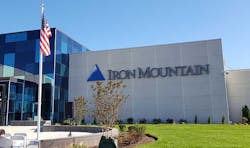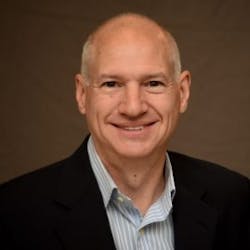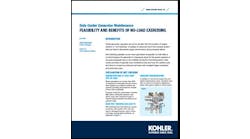Kevin Hagen of Iron Mountain explains how asking the right questions of your data center provider can turn a potential sustainability liability into an opportunity.
Kevin Hagen, Vice President Environment, Social & Governance (ESG) Strategy at Iron Mountain.
It’s a fact we know all too well. Data centers consume a lot of power – and demand is only growing. According to the Natural Resources Defense Council (NRDC), data center power consumption is projected to be 140 billion kilowatt-hours annually by 2020, roughly the annual output of 50 power plants.
In a world rightly concerned about climate change and environmental responsibility, growing energy requirements can be a liability. As more and more customers demand efforts toward a sustainable future, ignoring environmental impact brings risk. That’s especially true in the data center industry.
If we can’t demonstrate a commitment to reducing our impact, there’s an existential threat to our industry that is posed by the environmental consequences of our energy consumption. The threat to our industry is a social license to operate, and inaction could have direct business consequences.
The good news is that the story doesn’t end there. As decision makers, we can make business-savvy, financially viable choices that help make us part of the solution instead of part of the problem.
All we need to do is get smarter about the way we define and specify our energy consumption, so that we can use our purchasing power as part of the solution. We can change our decision-making, promote environmental responsibility and drive a greener grid for everyone.
The biggest movers in the industry have already paved the path. Google, Microsoft, Apple and Amazon have taken risks and invested early in green energy. By working to green their own operations, they have created new market opportunities for corporate purchases of renewable energy that enable the rest of us to follow this same path.
With a few actionable steps, you can use your energy purchasing power as part of the solution.
First Things First: Understand Your Company’s Commitments
The first step is to look inside and understand your own organization’s goals and mandates. Does your company have a sustainability commitment? If so, what are your metrics?
Reach out to your sustainability and corporate responsibility team for insight. Perhaps your company is one of the thousands of companies that report greenhouse gas emissions publicly. In fact, more than 600 companies have committed to setting science-based carbon reduction targets and over 200 corporations have signed up to be 100% renewable energy via the RE100 program.
If your company doesn’t have public commitments, perhaps there is someone working on these efforts. Ask how you can support them as a data center decision maker.
Whether or not your company’s sustainability goals are public, in the works or just a twinkle in someone’s eye, there are three key questions that will help you make good choices about energy sourcing. This can help save money, reduce risks and differentiate data center providers who are likely to be doing things well.
Question #1: Do You Publicly Report Your Carbon Footprint and Energy Usage?
Does your data center provider report on their carbon footprint and energy usage? Transparency is the cornerstone of trust and is a key indicator of a reliable business partner. If they know their carbon footprint and disclose their environmental impacts, they’re probably doing a lot of things right. Putting real data in the public domain is a key differentiator between a good green talk track and real accountability.
Questions #2: Do You Use Renewable Energy to Power Your Data Centers?
Next, ask your data center provider where their power comes from, and if they make a choice to source high quality renewable energy.
For many organizations, data centers create a large portion of their carbon footprint. Using green energy to offset your energy consumption will go a long way in meeting sustainability goals.
In the past, many customers hesitated to demand green energy because they believed it was expensive. But that was then, this is now.
Today, renewable energy is not only often less expensive than brown power, sophisticated buyers are negotiating long term fixed-price or stable-price contracts for energy. This means that going forward, energy costs from companies that use renewables are likely to be more stable and offer more reliable pricing than fossil fuels. Price volatility is an enemy, especially when it’s a big part of the cost of doing business in a data center.
Green energy is not only good for the planet, it makes business sense.
Question #3: Can We Get Credit for Your Green Energy?
Finally, if your data center provider does use renewable energy, ask if you can get credit for their green power usage. Ask if they can provide documentation so that your company can claim carbon reductions and green power usage in your reporting.
While claiming this credit was difficult in the past, new protocols developed by the Future of Internet Power (FoIP) offer a solution.
The Future of Internet Power (FoIP) is a consortium made up of top colocation customers, suppliers and other stakeholders, including Iron Mountain. Convened by Business for Social Responsibility (BSR) and the Renewable Energy Buyers Alliance (REBA), the group worked together to create a solution that would enable retail data center and colocation customers of all sizes to be able to report green power usage and carbon reductions suitable for the rigorous expectations of reporting agencies like CDP and WRI.
The FoIP collaboration group published a “best practice” white paper or protocol for data center customers to report the benefits of green power contracted by data center owners. This open source industry practice requires specific documentation deliverables so that you can claim the benefits in your public reporting.
Transparency is the cornerstone of trust and is a key indicator of a reliable business partner. If they know their carbon footprint and disclose their environmental impacts, they’re probably doing a lot of things right.
The three things included in the FoIP protocol are a contractual agreement, certified renewables with an audited chain of custody, and a letter of attestation transmitting the benefits.
Iron Mountain’s Green Power Pass is an example of a product that does just that. Green Power Pass is a renewable energy reporting solution that is built on the new carbon reporting protocol and based on our 100 percent renewable energy colocation offering.
Key stakeholders in Iron Mountain’s Green Power Program (GPP), from left to right): Rick Crutchley VP GM of North American Data Centers for Iron Mountain; Mike Mattera, Senior Program Manager for Sustainability at Akamai (GPP customer); Illina Frankiv, Global Energy Program Manager at WeWork (GPP customer); Kelly Saunders, Project Coordinator Sustainability at Arizona State University (GPP customer); Berkley Rothmeier from BSR Future of Internet Power; Marty Spitzer, Senior Director for Energy at Renewable Energy Buyers Alliance; and Kevin Hagen Vice President, Environmental Social & Governance Strategy, Iron Mountain. (Photo: Iron Mountain)
Green Power Pass is an industry endorsed, fully transparent solution for companies seeking to report greenhouse gas or CO2 reductions associated with the green power they consume at Iron Mountain data centers. With Green Power Pass and our transparent accounting process, we can now pass those renewable energy benefits on to our customers.
Products like this open the door for thousands of companies to have access to renewable energy for their data center footprint. More customer access means more green power demand – and that will lead to a greener grid for everyone.
Demand for Change
By asking for green energy, you become part of the solution. You’re helping data center suppliers recognize the demand and begin to find market-based solutions. Together, we can help create market-based solutions to environmental challenges. We can put business to work making better outcomes.
When we get smarter about how we define and specify our energy consumption, we can use our purchasing power as part of the solution. Then, with apologies to Marvel Comics, you can literally and figuratively use your power for good.
Kevin Hagen is Vice President Environment, Social & Governance (ESG) Strategy at Iron Mountain.






